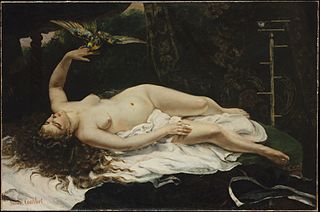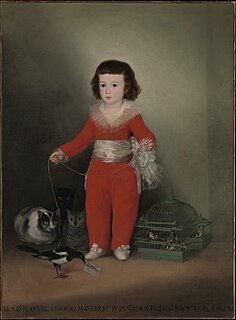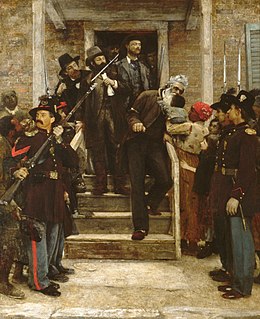
Ferdinand Victor Eugène Delacroix was a French Romantic artist regarded from the outset of his career as the leader of the French Romantic school.

Winslow Homer was an American landscape painter and printmaker, best known for his marine subjects. He is considered one of the foremost painters in 19th-century America and a preeminent figure in American art.

Jonathan Eastman Johnson was an American painter and co-founder of the Metropolitan Museum of Art, New York City, with his name inscribed at its entrance. He was best known for his genre paintings, paintings of scenes from everyday life, and his portraits both of everyday people and prominent Americans such as Abraham Lincoln, Nathaniel Hawthorne, Ralph Waldo Emerson, and Henry Wadsworth Longfellow. His later works often show the influence of the 17th-century Dutch masters, whom he studied in The Hague in the 1850s; he was known as The American Rembrandt in his day.

Jules Joseph Lefebvre was a French figure painter, educator and theorist.

Petrus Christus was an Early Netherlandish painter active in Bruges from 1444, where, along with Hans Memling, he became the leading painter after the death of Jan van Eyck. He was influenced by van Eyck and Rogier van der Weyden and is noted for his innovations with linear perspective and a meticulous technique which seems derived from miniatures and manuscript illumination. Today, some 30 works are confidently attributed to him. The best known include the Portrait of a Carthusian (1446) and Portrait of a Young Girl ; both are highly innovative in the presentation of the figure against detailed, rather than flat, backgrounds.

The Milkmaid, sometimes called The Kitchen Maid, is an oil-on-canvas painting of a "milkmaid", in fact, a domestic kitchen maid, by the Dutch artist Johannes Vermeer. It is now in the Rijksmuseum in Amsterdam, the Netherlands, which regards it as "unquestionably one of the museum's finest attractions".

The Everson Museum of Art in Downtown Syracuse, New York is a major Central New York museum focusing on American art.

Harriet Whitney Frishmuth was an American sculptor known for her works in bronze.

The Wine Glass is a 1660 painting by Johannes Vermeer now in the Gemäldegalerie, Berlin. It portrays a seated woman and a standing man drinking in an interior setting. The work contains the conventions of genre painting of the Delft School developed by Pieter de Hooch in the late 1650s. It contains figures situated in a brightly lit and spacious interior, while its architectural space is highly defined. The figures are set in the middle ground, rather than positioned in the foreground.
Harmonia, was a Sicilian princess, daughter of Gelo, the son of King Hiero II of Syracuse. She was the wife of Themistius.

Adelaide Alsop Robineau (1865–1929) was an American china painter and potter, and is considered one of the top ceramists of American art pottery in her era.

A Girl Asleep, also known as A Woman Asleep, A Woman Asleep at Table, and A Maid Asleep, is a painting by the Dutch master Johannes Vermeer, 1657. It is now in the Metropolitan Museum of Art in New York City and may not be lent elsewhere under the terms of the donor's bequest.

Anne Goldthwaite was an American painter and printmaker and an advocate of women's rights and equal rights. Goldthwaite studied art in New York City. She then moved to Paris where she studied modern art, including Fauvism and Cubism, and became a member of a circle that included Gertrude Stein, Henri Matisse, and Pablo Picasso. She was a member of a group of artists that called themselves Académie Moderne and held annual exhibitions.

The Horse Fair is an oil-on-canvas painting by French artist Rosa Bonheur, begun in 1852 and first exhibited at the Paris Salon in 1853. The artist added some finishing touches in 1855. The large work measures 96.25 in × 199.5 in.

Vincent van Gogh enjoyed making Paintings of Children. He once said that it's the only thing that "excites me to the depths of my soul, and which makes me feel the infinite more than anything else." Painting children, in particular represented rebirth and the infinite. Over his career Van Gogh did not make many paintings of children, but those he completed were special to him. During the ten years of Van Gogh's career as a painter, from 1881 to 1890, his work changed and grew richer, particularly in how he used color and techniques symbolically or evocatively.

La Femme au perroquet is an oil painting on canvas by French artist Gustave Courbet. It was the first nude by the artist to be accepted by the Paris Salon in 1866 after a previous entry in 1864 was rejected as indecent. It is in the collection of the Metropolitan Museum of Art in New York city.

Birgitta Moran Farmer (1881–1939) was an American artist particularly known for her portrait miniatures.

Manuel Osorio Manrique de Zúñiga is a large full-length portrait in oil painted in 1787–88 by the Spanish artist Francisco Goya. It depicts a boy three or four years of age, standing in red clothes, with birds and cats. It is also known as Goya's "Red Boy". It was described by art historian Claus Virch in 1967 as "one of the most appealing and successful portraits of children ever painted, and also one of the most famous". The painting has been held by the Metropolitan Museum of Art in New York since 1949.

Rosa Bonheur is an 1898 painting by Anna Elizabeth Klumpke. The portrait of the French artist Rosa Bonheur has been in the collection of the Metropolitan Museum of Art since 1922.

The Last Moments of John Brown is a late 19th-century painting by Irish-American artist Thomas Hovenden. Done in oil on canvas, the painting depicts American abolitionist and insurrectionist John Brown being led to his execution. The painting is on display at the Metropolitan Museum of Art.



















